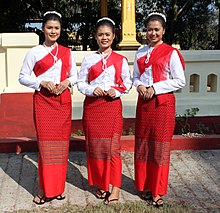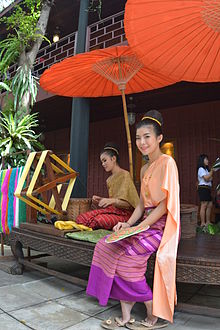Sbai
This article has multiple issues. Please help improve it or discuss these issues on the talk page. (Learn how and when to remove these template messages)
|

Sbai (Khmer: ស្បៃ [sɓaj]; Thai: สไบ; Lao: ສະໄບ; Malay: Sebai; Jawi: سباي, RTGS: sabai [sābāj]) or phaa biang (Lao: ຜ້າບ່ຽງ; Thai: ผ้าเบี่ยง [pʰâː bìa̯ŋ]) is a shawl-like garment or breast cloth worn in mainland Southeast Asia. Sbai is worn by women as a silk breast wrapper in Cambodia, Laos, and Thailand, while in coastal Sumatra, Borneo and Malay peninsula, the same term is used to describe a shoulder cloth.[1]: 410 The sbai was derived from the Indian sari, the end of which is worn over one shoulder.[1]: 153
Etymology
Sbai, In Thai, this type of cloth is called "stripe cloth". In the 2011 Royal Institute dictionary, it means "a long, narrow piece of cloth used to cover the chest across the shirt." There is another word, "Sabai", meaning Means "band cloth, women's shawl", while Supat Chareonsapphuet (2020) explains that the word may have its origin or is related to the word Sapay, which is an Austro word. traditional Nesian which means "Hanging across the shoulders" or "rope railing"[2][3][4][5][6][7] In addition, in Thailand, it is also called a sabai called Pha Krasaeng, Krasaeng or Krasaeng [8] and another commandment for blanketing is called "Ta Beng Man" or " Tabangman" means "a method of covering a strip of cloth by tying the diaper from the back crossed up to the front then took the two men and tied them around their necks."
History
Sbai is derived from the Indian sari which may have been introduced to Southeast Asia through the Indianized Kingdoms along with other traditions and elements of Indian culture.[1]: 153

Cambodia

The sbai is mentioned in the legends of Preah Thong and Neang Neak. In one scene, Preah Thong clings to a piece of cloth worn on the Nagini in order to make the journey to the Nāga's kingdom; that piece of cloth is a sbai. In that tale, the sbai is symbolic of the tail of Neang Neak, the Naga princess.[9][10]
In Angkorian period, although it was common for men and women to be topless, however clothes for the upper body were worn: the bas reliefs of Bayon, Preah Khan, and other Angkorian temples depict women wearing a shawl-like sbai while religious male figures are adorned with stylized sbai. At Angkor Wat, there are depictions of topless Apsaras holding sbai connected to their sampot, while the northern wall of Angkor Wat depicts a group of ladies wearing long sbai holding various offerings.
Nowadays, sbai along with chang kben and sampot are regarded as Cambodia national costume.[11] Sbai is newly introduced using in traditional Khmer weddings with different type and decoration during the popularity of Love Destiny (TV series) on air in Cambodia.
Laos

In Laos, this garment is known as phaa biang or sabai. It is common for Lao women to wear sabai as it is considered traditional clothing. A sabai can also be worn by men in weddings or when attending religious ceremonies. The type of sabai typically worn by Lao men often has checkered patterns. Sabai can also be a long piece of silk, about a foot wide, that is draped diagonally over the chest covering one shoulder with one end dropping behind the back.[12]
Malaysia
In Malaysia, Sebai is a cloth wrapped around the neck to cover the shoulders with both ends hanging on the chest similar to a scarf hung over the shoulders.[13]
Myanmar

The ethnic Mon is also known to have similar tradition of wearing the shawl-like sabai called Yat Toot in Mon language, diagonally over the chest covering one shoulder with one end dropping behind the back like that worn by Lao women. This tradition distinguished them from other ethnic groups in Myanmar. The today Mon people of Myanmar and Thailand were the descendants of various Indianized polities notably Dvaravati.[citation needed] Artifacts from Mon Dvaravati sites in what is now Thailand depicted a group of ladies wearing what is similar to sabai.
Thailand

Dvaravati sites depicting group of ladies wearing what is similar to sabai. Sabai (Thai: สไบ, RTGS: sabai, pronounced [sābāj]) or pha biang (Thai: ผ้าเบี่ยง pronounced [pʰâː.bìaŋ]) is shawl-like garment, or breast cloth. Sabais can be used by women or men. The sabai is also known as a long piece of silk, about a foot wide, draped diagonally around the chest by covering one shoulder which its end drops behind the back. Sabais could be worn around the naked chest or on top of another cloth.
In the Thai royal court Evidence of wearing a sabai and covering a cloth over another one has been found since the Ayutthaya period. Because there is evidence of wearing a law for dressing in the royal court there is an evaluation of the pattern, fabric, production process. Most of them are imported from abroad. and made from expensive materials indicating the dignity of the wearer It was a custom for court officials and high-ranking women at that time to wear clothes only when participating in important ceremonies with full dress. because it is a tradition to show courtesy to the public since ancient times inner royalty and court ladies have a tradition that they cannot be young themselves. But must get permission from the caretaker first. After the royal ceremony The caretaker will be ordered to change the dress to a saak. Therefore, wearing a robe is a symbol of being a royal woman. The practice of wearing Sabai along with Victorian cloth was a common practice during the reign of King Chulalongkorn and lasted until the reign of King Vajiravudh when Westernized clothing became more fashionable. However, Thai dress is mostly used worldwide for Thai people in ceremonies or Thai organization to represent the culture and history for the centuries.
Gallery
-
Figures wearing sbai depicted on the Bayon temple, Angkor Wat
-
Figures wearing stylised sbai depicted on Angkorian temples
-
Queen Ang Mey and her daughters wearing sbai in the 1800s
-
Lady Pun Bunnag, Somdet Chaophraya Borom Maha Sri Suriwongse's wife wearing pha biang, 1866
-
Siamese girl wearing pha biang, 1921
-
Daughters of King Rama II and King Rama III wearing pha biang in the 1800s
-
Queen Debsirindra, the second consort of King Mongkut wearing pha biang, 1855
-
Cambodian bride wearing a sbai in a wedding ceremony
-
Dancer wearing sbai
-
Different styles of wrapping sbai used in Cambodia
See also
- Sampot Chang Kben
- Khmer Traditional Dress
- Culture of Cambodia
- Chut thai
- Sampot
- Sampot Samloy
- Kemben
- Malaysian cultural outfits
- Sari
- Traditional Thai clothing
References
- ^ a b c Maxwell, Robyn J.; Gittinger, Mattiebelle (2003). Textiles of Southeast Asia: Tradition, Trade and Transformation. Periplus Editions. ISBN 9780794601041.
- ^ Chareonsapphuet, Suphat (June 29, 2020). ""'Sabai' Khom word that (probably) is not Khmer".
- ^ Banchun, Ong (2009). [www.openbase.in.th "Mon Sabai"].
{{cite web}}: Check|url=value (help) - ^ Blust, Robert A., Trussel, Stephen (2010). AustronesianComparative Dictionary.
{{cite book}}: CS1 maint: multiple names: authors list (link) - ^ Pittayaporn, Pittayawat (2009). [www.ecommons.cornell.edu "The Phonology of Proto-Tai"]. In Partial Fulfillment of theRequirements for the Degree of Doctor of Philosophy, Faculty of the Graduate Schoolof Cornell University.
{{cite journal}}: Check|url=value (help) - ^ Shorto, Harry (2006). A Mon-Khmer Comparative Dictionary. Pacific Linguistics.
- ^ Zorc, R. David (1990). The Austronesian monosyllabic root, radical or phonestheme. Linguistic Change and Reconstruction Methodology: De Gruyter.
- ^ Learning Park Office Under the Office of Knowledge Management and Development (Public Organization) (2020-07-24). "Characteristics of fabrics used by high-ranking people in the early Rattanakosin period".
- ^ "Custom & Tradition". www.cambodiancommunityday.org. Retrieved 2020-03-09.
- ^ Nadeem, Zuha (2019-10-01). "Traditional Thai Clothing-16 Beautiful Outfits From Thailand". Outfit Trends - Ideas How to Wear & What to Wear. Retrieved 2020-03-09.
- ^ Books, Better World. "Buy New & Used Books Online with Free Shipping". Better World Books. Retrieved 2020-02-24.
- ^ Bonnie Ghazarbekian, Jane Siegel, Sawaddi, 15 years, p.130.
- ^ "Carian Umum - Sebai". prpm.dbp.gov.my (in Malay). Retrieved 2020-11-15.
External links
![]() Media related to Sbai at Wikimedia Commons
Media related to Sbai at Wikimedia Commons











